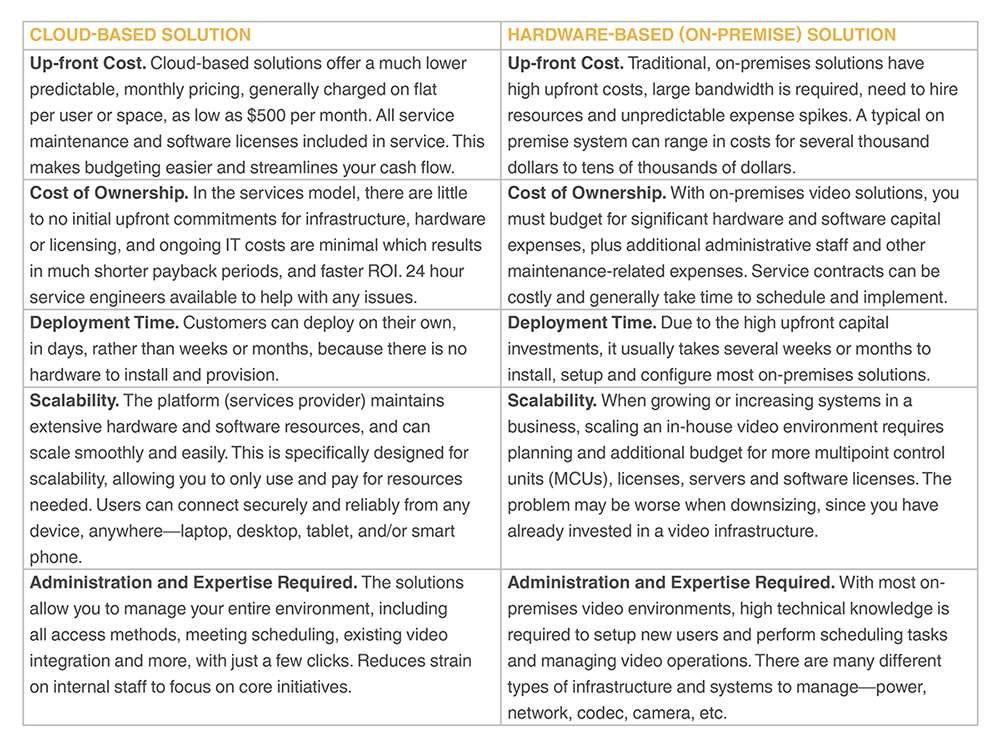Have you ever asked yourself how can I save my business money and improve efficiency? How about your clients business? It may not seem like a probable answer but cloud-based videoconferencing can do just that.
Videoconferencing has for a long time been looked at as a way to communicate remotely with anyone on the planet. Reducing travel costs, improving communication efficiency, and accelerating accurate decision-making have always been the key benefits of deploying videoconferencing systems. Videoconferencing has also traditionally been a hardware-centric technology solution. Over the past several years the audio visual industry has started a shift from a hardware-centric to a software and service centric solution.
Only in recent years with the advent of powerful video codecs combined with high-speed internet broadband and ISDN service did videoconferencing become a practical technology for regular use.
Though long looked at as being an alternative to traveling across the globe to conduct face to face conferences and training, the cost and maintenance of these systems was prohibitive and often required higher technical aptitude to function properly and maintain. Companies, schools and facilities would most often dedicate rooms for videoconferencing and the demand was high for these rooms, yet the use was limited to facilities that also had videoconferencing hardware. The use of these systems started out with networks such ISDN networks in the 80’s and IP capability started in the late 90’s.
The new millennium brought along the ability for personal users to have video calls at their desktops via applications such as Skype and iChat, yet the quality was not ready for larger meeting sizes and was not easily integrated into conference rooms.
The amount of bandwidth videoconference systems utilize has always been a challenge and the technology has now reached heights that allow HD quality videoconferencing at significantly lower bandwidths than ever before. With the emergence and improvements in IP videoconference capabilities along with improved low cost and high speed data services many doors have opened up that did not exist before for those with a need to employ videoconference solutions.
Through lifelike high resolution videoconferencing experienced in real time, along with the wide-spread use of technology and the variety of industry-specific applications, we are now in an e-Conferencing world!
 This shift has opened doors for videoconferencing to be utilized for a number of innovative applications that have been created in areas such as emergency command, e-health, online education, and e-court. This combined with the ability for traditional videoconference users to purchase more cost effective solutions and increase the number of systems they deploy in their facilities has brought about a higher demand and shift in utilization for these types of systems.
This shift has opened doors for videoconferencing to be utilized for a number of innovative applications that have been created in areas such as emergency command, e-health, online education, and e-court. This combined with the ability for traditional videoconference users to purchase more cost effective solutions and increase the number of systems they deploy in their facilities has brought about a higher demand and shift in utilization for these types of systems.
The move to hosted cloud-based video conferencing solutions rather than owning solutions is becoming a more comfortable approach for customers. This approach also protects users from the worry of technologies becoming obsolete and dealing with continued cost of maintenance, upgrades, and repairs like traditional videoconference systems incur.
Mobility is another benefit to the “cloud based solutions and services approach” as now users can join in on video calls utilizing simple applications that can easily be loaded onto their laptops, iPads and mobile devices.
Some of the key technology enablers are virtualization technologies, wider adoption of standards-based protocols such as Session Initiation Protocol (SIP) and H.264. Development of software based solutions also makes it easier to ensure mobile solutions can integrate with existing room-based and executive style systems.
 There has recently been a huge shift in the videoconference world with the fast growth of ‘cloud videoconferencing systems’. Cloud-based videoconference systems are software and service-oriented solutions that allow users to bridge all different forms/formats of videoconferencing and allow users the flexibility of attending meetings from wherever they are, regardless of what their method, i.e., in an office, conference room, at home, a lobby or even sitting in their car in a parking lot.
There has recently been a huge shift in the videoconference world with the fast growth of ‘cloud videoconferencing systems’. Cloud-based videoconference systems are software and service-oriented solutions that allow users to bridge all different forms/formats of videoconferencing and allow users the flexibility of attending meetings from wherever they are, regardless of what their method, i.e., in an office, conference room, at home, a lobby or even sitting in their car in a parking lot.
In the workplace the most commonly used cloud-based systems are Lync, Vidyo, Skype, Google Hangouts and WebEx, in addition, the most commonly used hardware-based solutions are Polycom, Cisco, Lifesize, Vidyo and Sony. Companies that now provide services to bridge all cloud-based and hardware-based solutions are Blue Jeans, Vidyo, Cisco, Lifesize and Polycom.
As IT continues to tackle the headaches of bandwidth and network management, video usage is expected to grow exponentially.
Questions about which solution is best for your workplace?
Here’s a side-by side comparison of the cloud-based and hardware-based solutions available.

For expert help on choosing which cloud-based videoconference solution is best for your company and/or clients please contact PlanNet. One of our AV specialists will be on hand for a consult to discuss this and any other audio visual needs.





